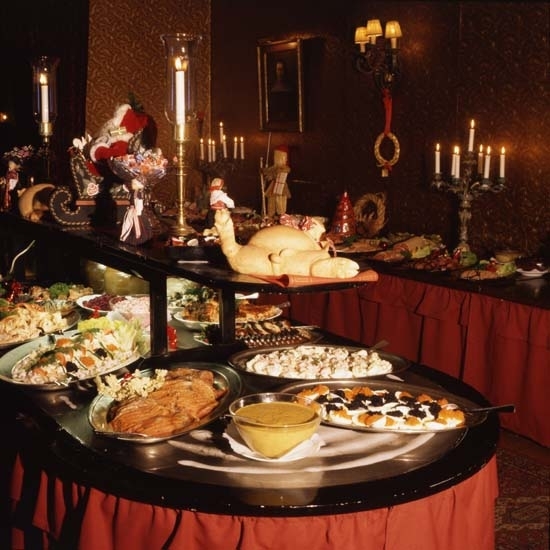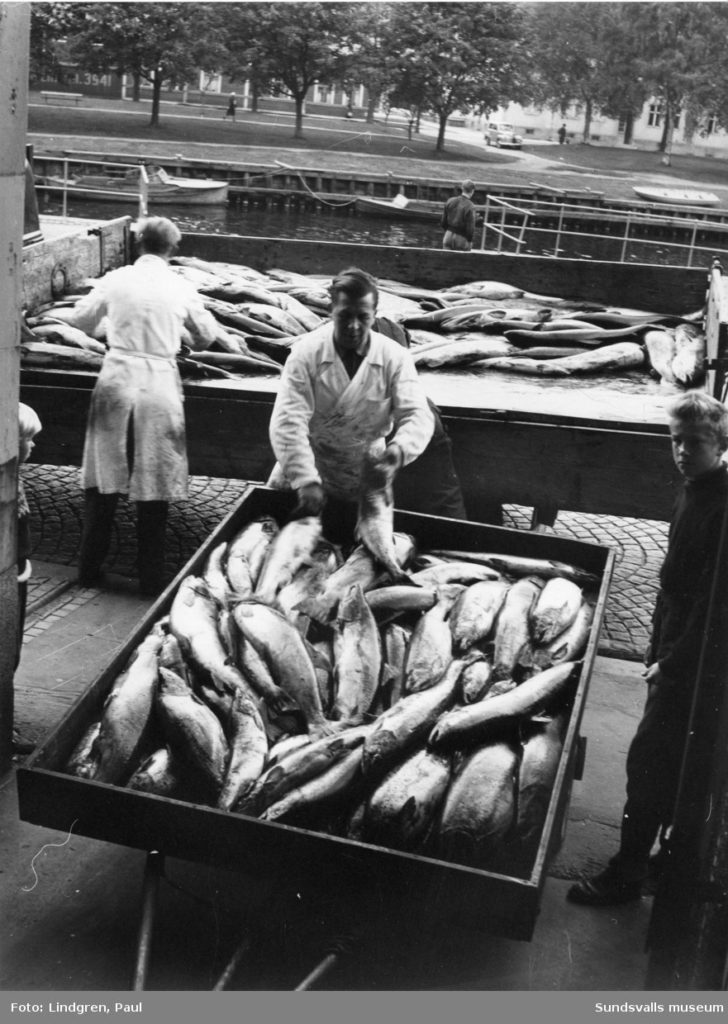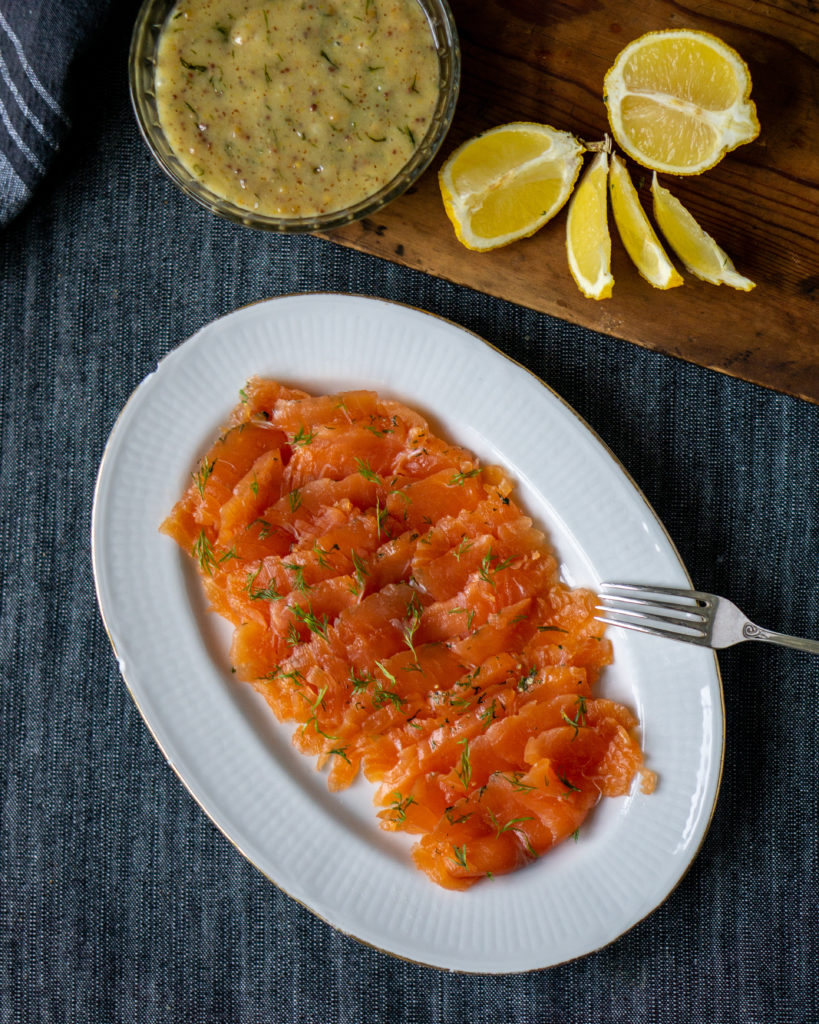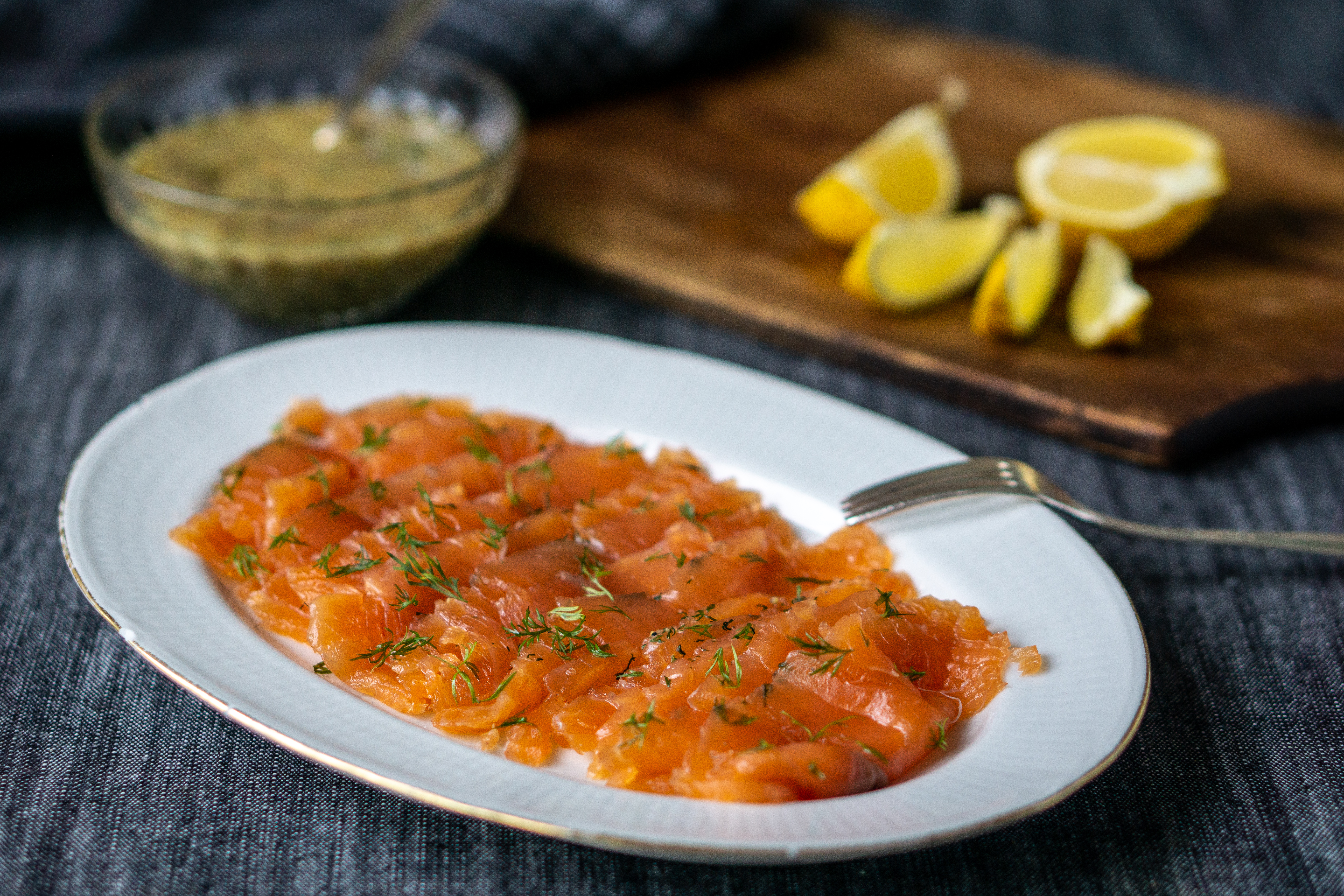Swedes enjoy gravlax as an essential part of the festive Swedish smörgåsbord, such as Christmas, served with a sweet and strong mustard sauce. Although the cured fish mostly is eaten cold, you can enjoy it around the year. You can also serve it with potatoes as a standalone dish.
The history of gravlax in Sweden
As noted by Magnus Nilsson in The Nordic Cookbook, the name gravlax or gravad lax comes from the Swedish word that means “to bury”. Jan-Öjvind Swahn describes curing the salmon as a necessity back in the days where it was challenging to sell the salmon at the same time of year as it was caught. Instead, the fishermen dug a large hole that they clad with bark and moss, and then placed the fish in the hole, together with large amounts of salt. Then the hole was covered well from wild beasts until the waterways froze over and made it easy to bring the salmon to the market. The salt preserved the fish and kept it from rotting, although it did get smelly…
Swahn also notes that thanks to a French guest of the nobleman and politician Axel Oxenstierna, we know that Oxenstierna loved cured salmon, which he served cut in thin slices with a sauce with mustard, oil, and vinegar. That sounds like the way we serve it today — although this was in the 1640s. In 1642, Andreas Palmcron in Sundhetzens Speghel described how salmon is salted or smoked so it can be transported to areas without salmon. However, health-focused Palmcron considers the salted or smoked salmon a bit more difficult for the stomach to digest.
I had a hard time reading Gustafwa Björklund’s recommendations from 1847 without giggling. For example, she recommends that you get a female salmon and describes cutting up the salmon to the navel — salmons have navels..? Björklund suggests that you rub the salmon with saltpeter (sodium nitrate) and sugar, “one large handful of each for a large salmon”. Then you pour on “normal table salt” and sprinkle on dill, before placing the two salmon pieces against each other. The saltpeter must speed up the process considerably, as Björklund claims that it is ready to eat after just one hour.

How chefs make gravlax today
Salmon is typically cured by rubbing a mixture of salt and sugar onto the salmon. Leif Mannerström has a slightly different approach and adds water and cognac to the curing mixture to ensure that it cures the salmon evenly. He lets the salmon cure for at least two days before he cuts off the skin, fries the skin, and serves it with the salmon cut in large pieces.
According to their Christmas cookbook, the highly esteemed restaurant Oaxen removes the skin to make the curing more even, as “the curing almost only happens from one side when the skin remains”. They also “over-cure” the salmon and then rinse off the curing brine to add the final flavors. Oaxen recommends vacuum packing the salmon, and if you don’t have access to a vacuum packer (I don’t), that you let the fish be “well wrapped and as airtight as possible”.
Magnus Nilsson lets his salmon cure for 24 hours, and then wash off the cure mix and lets it rest for another 24 hours, so the curing will become evener.
In Menu, Tore Wretman starts by rubbing a little bit of oil over the fish, and he also places a weight over the fish. For a slightly more brutal-sounding version, “Ane den Gamle” writes in Svenska Dagbladet in 1925 about his childhood’s gravlax, where the salmon was rubbed with its own blood as part of the curing process.
So, what about the mustard sauce?
In 1863, Anna-Maria Zetterstrand served her fish with a sauce of vinegar, oil, salt, pepper, and sugar. With his recipe for “Graflax — saumon au naturel à la suédoise”, Charles Emil Hagdahl’s 1896 cookbook returns to the mustard sauce that scared Oxenstierna’s guest in the 17th century, serving the fish with oil, vinegar, salt, pepper, mustard, and sugar.
The recipes in Prinsessornas kokbok from 1934 and Stora kokboken from 1946 use the same ingredients but recommend that you mix the sauce yourself on your plate. I’d advise against this, as it can take a bit of whisking to make the sauce into an emulsion.
Leif Mannerström adds red wine vinegar, soy sauce, and Worcestershire sauce to his, but most recipes have fewer ingredients. In The Nordic Cookbook, Magnus Nilsson prefers using brown sugar instead of white and tends to leave out the dill. Tore Wretman considers it part of the charm to mix the sauce at the table, and apart from the regular Swedish mustard, he also wants some “French dark estragon mustard”.

The importance of high food safety
Gravlax is delicious, but in extremely rare cases, botulinum toxin can develop in cured fish, and botulism can be fatal. Regardless, it is crucial to handle the fish correctly to avoid “normal” food poisoning. My recommendations:
- Freeze the fish. This is optional but recommended. Previously, I’ve seen recommendations for freezing all fish that will be eaten raw, as it can contain parasites that won’t be killed by curing the salmon. Even though I’ve seen that advice from Swedish Livsmedelsverket abolished, I still stick to freezing the salmon for three days before defrosting and curing it. Also, I don’t know what kind of salmon you’ll find. If you use “sushi grade” salmon, you’ll always be fine, but I tend to buy half a salmon with the skin still left on.
- Observe the highest possible food hygiene. For example, I place my fish on a baking paper instead of directly on the cutting board, use gloves, and wrap the fish in double plastic bags that I put in a plastic container, to ensure it doesn’t leak.
- Cure the fish well. Don’t reduce the amount of salt and sugar in the recipe.
- Keep the fish cold. Be mindful of not leaving the fish out for long periods of time once it is ready — hours on a smörgåsbord isn’t good for food safety.
I do not mean to deter you, but better safe than sorry.

How to make gravlax with dill and a mustard sauce
Ah, the classic combination! Gravlax together with a dollop of hovmästarsås is difficult to resist.
Gravlax — cured salmon with dill
Cured salmon is easy to make and doesn’t require a lot of work. Please do pay attention to the discussion above on safety before you begin.
Instructions
1 kilo (2 pounds) salmon
1 dl (0,4 cups) sugar
4 tbsp salt—don’t use mineral salt or iodized salt
2 tsp roughly ground white pepper
1 dl (0,4 cups) or one bundle of dill
For serving: extra dill, hovmästarsås (mustard sauce)—see recipe below
Instructions
- If you’ve frozen the fish, let it defrost first.
- Cut the salmon into two pieces of similar size. Pat them dry. If you’ve got a salmon side, remove the small greyish area at the lower part of the stomach.
- Mix sugar, salt, and white pepper together. Chop the dill finely.
- If you’ve got salmon with skin (scales), you can make a few cuts in the salmon skin to make it easier for the curing to become evener.
- Place the salmon pieces flesh-side up and rub the top surface with most of the salt mixture. Sprinkle on the dill.
- Place one salmon piece on top of the other, placing a thicker side against a thinner. Sprinkle on the rest of the salt mixture.
- Place the salmon in a freezer bag (or two) and tie a knot. Put it on a plate or in a container. Now the salmon is ready to be stored in the fridge for 1-3 days, depending on how cured you want it. I tend to go for 2-3 days, but it depends on the thickness of the salmon. Turn the bag 2-3 times per day, so it cures evenly.
- When you’re ready to serve, scrape off the dill and pepper and maybe add fresh dill. Cut thin pieces at a slight angle.
- The salmon keeps for about a week, provided that you don’t leave it out for long periods of time and store it well.
Hovmästarsås—”sauce Maître d’hotel”
A strong and sweet mustard sauce. You’ll get the best result if the mustard and the oil are of the same temperature when you start. I enjoy using a roughly ground version of Swedish mustard and swapping white sugar for brown, but use whatever you have on hand. Both mustards in the ingredients list are already ground into thick pastes — if you use mustard seeds, you’ll need to taste-test and adjust the sweetening, vinegar, and oil until you have a nice flavor and consistency.
Ingredients
1 tbsp dijon mustard
2 tbsp Swedish mustard—roughly ground is great if you have it
1 tbsp sugar—white or brown
1 tbsp white wine vinegar
1/2 tsp salt
a little white pepper
2 dl (0,8 cups) neutral oil, such as rapeseed oil or sunflower oil
about 1 dl (0,6 cups)—or a bundle of dill
Instructions
- In a bowl, blend the mustard, sugar, vinegar, salt, and pepper.
- Start whisking with a manual or electric whisk. Add the oil little by little and whisk until it is absorbed by the sauce before adding more. Keep whisking, and the sauce will emulsify.
- Stir in the dill, and you’re ready to serve it with your beautiful gravlax!
Suggestions
You can flavor the cured salmon however you like! Just skip the dill and add another flavor combination instead, once you’ve added the salt-and-sugar mixture to the salmon. Grated beetroot, or vodka and lemon, or ginger, lime, and chili? These are just a few of the examples that I’ve seen.
When it comes to the sauce, there really isn’t a way to turn it into a light-version—it is mayonnaise-like, but the acidity from the vinegar makes it less heavy.



Hi. Could you just confirm : when you mention in the ingredients “2 tbsp Swedish mustard—roughly ground”, I suppose you mean mustard seed ?
Are dill seeds also used sometimes in preparing Gravlax or other Swedish preparations ?
Thanks for your wonderful recipes.
Hi Robert, I mean mustard sauce, but the roughly ground version. Thank you for pointing out that it is unclear, I’ll fix it!
I’d say we tend to use the green dill leaves much more in the Swedish kitchen, but dill seeds are mainly used fresh for boiling crayfish, but are also popular for pickling herring and making sauerkraut. I’ve yet to try them for gravlax but am sure they work well — let me know if you try it.